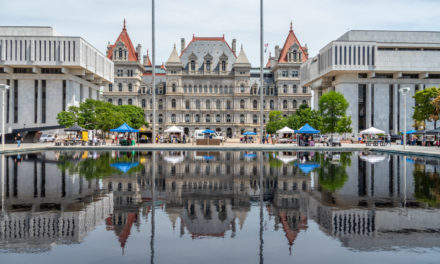Since CivMix has been up and running for a few weeks now, it seems like a good time to start introducing you to some of the people who make regular appearances on the site.
Many of the photos featured in the daily round-ups – “Rise and Shine” in the morning and “While You Were Out” at the day’s end – were taken by Fred Coffey. If you’re familiar with the Facebook page “Looking Good, Albany!“, you probably recognize his singular work.
He’s a frequent contributor there, as well as to several other sites.
Fred is a 62-year-old Binghamton native who has lived in the Capital Region for about a decade, and has called Albany home for the past year. He work overnights at Albany Med in the Patient Access Department, which coordinates all movement into and throughout the hospital.
Working overnights can be tough on both the body and the mind. But Fred says he has been doing it for many years, and it informs his work. Many of his photos are taken in the dead of night or at twilight, when few others are awake and shooting.
“The colors of the lights, signs, and ambient light from the sky, to me, is more dramatic than mid-day harsh sunlight,” Fred told me. “It’s also quieter, and more peaceful, and less traffic to deal with. It’s very relaxing to me, almost like a peaceful meditation, walking around, taking it all in, and capturing a single moment in time.”
Fred graciously agreed to participate in a Q-and-A about his work, his motivation and his plans for the future. He also sent along some sample photos to illustrate his responses. To see more of his work, you can also follow him on Instagram @Fredcoffey.
(This piece has been lightly edited for content, grammar and clarity).
Q: How did you get interested in photography, and how many years have you been taking photos?
“I was an art major in high school, and had been drawing and painting since I was very young. I joined the yearbook staff in my junior year, got bitten by the photography bug, and have been doing it on and off for years.”
“I was a corporate photographer back in the 80’s for a major manufacturer in Greene, NY, The Raymond Corporation, and did marketing, advertising, and engineering photography for them.”
Q: Why do you choose the subject matter that you do? You seem to focus a lot on architecture, nature, and iconic local landmarks.
A: “Since I have lived in Schenectady and Albany for the past 10 years that is what I shoot. It’s close, and I think the locals like to see pictures of the area – especially Albany, because it is not a rural area, and there is a great history to many of the local landmarks and buildings.
“There have been thousands of pictures taken of the state Capitol, and the Empire Plaza, which locals pass by every day, and take for granted. But they really are amazing structures. When I go out for a shoot, I try to look for something different, or present an everyday scene in a different light.”
“Perhaps the turning point in establishing myself as a reputable photographer came when I posted a shot of downtown Albany with the landmark clock and the D&H Building in the background.”
“This got a huge response. The mayor’s office reached out and wanted to use my photography for their media needs. To date, they have purchased the rights to use over 100 of my pictures of the greater Albany area.”

Q: What, to you, embodies the perfect shot?
A: “I don’t think there is any one thing that makes up a perfect shot. Photography is subject to the personal taste, likes and dislikes of the person viewing it. What one thinks is fantastic, another thinks is boring.”
“I’ve posted pictures that I thought were average that got a huge response. On the flip side, a picture that I was excited about, and planned, and spent a lot of time working on, gets a mediocre reaction. You just never know.”
Q: What’s the most elusive shot that you’ve been trying to get and haven’t managed yet?
A: “I don’t have any one particular shot that has eluded me. I’ve accomplished many goals and ideas, and places I want to photograph that I have on a running list. I get an idea, write it down, and add to the list, and cross them off as I do them.”
“Photography is always about light, light and shadows. The elusive part is being there at the right time when the light is just right for the subject matter. We are always chasing the light so to speak. The best light is usually early morning before sunup, and at dusk, as the sun goes down.”
“It’s also about timing too. Some days you plan to go out and catch a great sunrise with ‘xyz’ in the foreground, and the weather is terrible, or the skies are clouded over and a dull gray. Sometimes, inclement weather can be effective though, depending on the mood of the image you want to convey.”

Q: What’s your favorite photo taken locally?
A: “One of my personal favorites is called ‘Rush Hour.’ It’s a long exposure photo of a bus and traffic passing through the center of Albany at State and Eagle streets. I liked the motion, sense of speed, and the feel of commuters looking to get home after a long day at work.”

Q: How much manipulation do you do of your photos – online editing, that is – and did you ever shoot in film? If so, which do you prefer?
A: I started out with film. I processed my own black-and-white film and did my own printing. I spent hours and hours in my darkroom starting in high school and for years after. I resisted switching from film to digital, because I never thought it looked as natural, but advancements in the medium slowly changed my mind, and now, I would never go back.”
“As far as manipulation goes, I will enhance skies or various parts of the scene sometimes, but I am very meticulous when doing so, as I want it to look natural, and add to the overall quality of the picture. I only make adjustments and/or additions as needed to enhance the scene, rather than having someone say: ‘How did he do that?'”
“Sometimes I will remove a sign, or traffic light, street litter, or any other distractions that take away from the esthetics of the overall image. I use Adobe Photoshop CC for my editing, and the NIK software collection as a plug-in to that app.”
Q: What can people who have been following your work expect as you continue to evolve?
A: “I look for uniqueness in my images. I try to present a view that no one has seen before, or I want to invoke emotion, or interaction, especially in scenes of abandoned buildings or neighborhoods that people remember when those buildings were functional and a beautiful part of the community.”

Q: What’s your advice for people who might be interested in getting involved in photography?
A: “Just do it. Every day, if possible. Just go out and shoot. In today’s digital age, you don’t have to worry about the costs of film, processing and printing, you can get hundreds and hundreds of pictures for the low price of a single memory card.”
“Think of what you love, what inspires you – whether it be people, nature, flora, landscapes – and just go out and shoot, shoot, shoot. Practice makes perfect. Even the most gifted artists, athletes, and musicians didn’t get to where they are because of a natural God-given talent or skill. They have to do the work, and practice, practice, practice.”
“You don’t need a $5,000 set of camera and lenses, or the most expensive Smartphone to take good pictures. Remember, it’s the artist that makes the picture, not the brush or the paints.”




